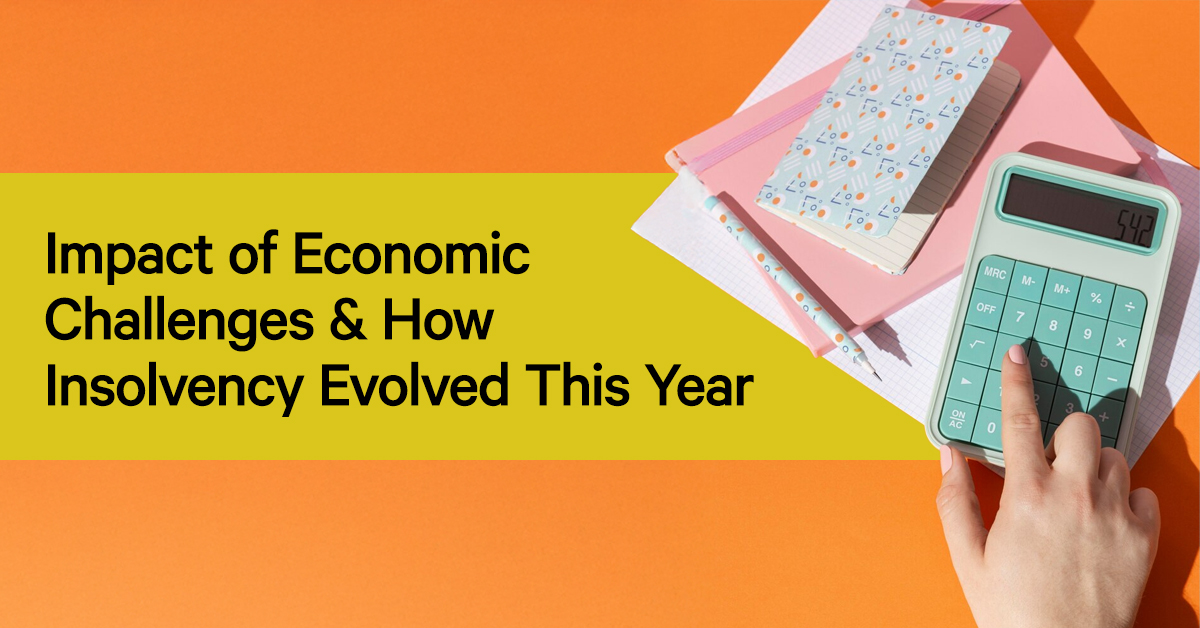The economic landscape in the UK has been shaped by significant challenges. From fluctuating energy prices to rising interest rates and the persistent aftermath of a global pandemic, businesses and individuals have faced mounting pressures. These dynamics have inevitably influenced the insolvency sector, prompting innovation, adaptation, and what we now call the insolvency evolution in 2024. This blog explores the key economic challenges this year, how insolvency practices have evolved, and what this means for businesses and individuals navigating financial difficulties.
Economic challenges in 2024
This year, the UK economy was characterised by volatility and uncertainty. Below, we outline some of the main factors contributing to financial distress:
1. Rising interest rates
To control inflation, the Bank of England maintained a policy of high interest rates throughout the year. While this slowed inflation, it increased borrowing costs for businesses and consumers. Many companies, particularly SMEs with variable-rate loans, have struggled to manage these higher repayment obligations.
2. Energy costs and supply chain issues
Despite some stabilisation compared to previous years, energy costs remained a significant burden, especially for energy-intensive sectors like manufacturing. Persistent supply chain disruptions added further strain, delaying projects and increasing operational costs.
3. Consumer confidence and spending
Household budgets remained tight due to high inflation and stagnant wage growth, leading to reduced consumer spending. For retail and hospitality businesses, this translated to lower revenues and thinner profit margins.
4. The ‘post-COVID’ recovery lag
Although the immediate effects of the pandemic have receded, many businesses are still grappling with the debt accumulated during that period. Coupled with new economic challenges, some have found recovery elusive.
Insolvency evolution in 2024
In response to these economic challenges, the insolvency sector has seen a remarkable transformation this year. The insolvency evolution in 2024 reflects not only regulatory updates but also shifts in strategies to meet the needs of modern businesses and individuals. Below are the key trends and developments shaping the insolvency landscape.
- Increased accessibility to advice and support
Traditionally, insolvency services were the last resort – a daunting step taken only when all other options had been exhausted. However, this year has seen a big shift toward early intervention and proactive advice. Insolvency practitioners have embraced technology to reach struggling businesses earlier, offering virtual consultations and user-friendly online tools to assess financial health.
2. Focus on rescue and recovery
There’s a greater emphasis on business rescue rather than closure. Techniques like Company Voluntary Arrangements (CVAs) and Pre-Pack Administrations have been refined, providing companies with structured paths to financial stability. This year has seen a significant uptick in successful restructurings, highlighting the efficacy of this rescue-first approach.
3. Innovation through technology
Technology has revolutionised insolvency processes in 2024. From sophisticated financial modelling tools that help predict outcomes to AI-powered platforms streamlining administrative tasks, the sector has embraced innovation. These advancements have reduced costs and improved the speed and accuracy of decision-making, benefiting both practitioners and clients.
4. Legislative changes and their impact
The UK government introduced updates to insolvency legislation in 2024 aimed at promoting fairness and transparency. Key reforms include enhanced protections for small creditors and streamlined processes for SMEs. These changes have levelled the playing field, ensuring insolvency procedures are more equitable and efficient.
5. Rising importance of personal insolvency solutions
With many individuals facing rising costs of living and debt, personal insolvency solutions have seen growing demand. Debt Relief Orders (DROs), Individual Voluntary Arrangements (IVAs), and bankruptcy remain essential tools. Practitioners have tailored their services to provide empathetic, non-judgmental support to individuals seeking help.
Looking ahead: Challenges and opportunities
As we move into 2025, several factors will shape the future of insolvency:
- Economic recovery
The global economy is expected to continue its gradual recovery from recent downturns. While this may lead to a decrease in insolvency cases, ongoing challenges such as high interest rates and inflation could still put pressure on businesses, particularly those operating in heavily leveraged sectors. Companies that fail to adapt to these economic conditions may find themselves at increased risk.
- Further technological integration
Technological advancements, especially in artificial intelligence (AI) and blockchain, are ready to play a big role in reshaping insolvency proceedings. AI can improve predictive analytics to anticipate financial distress, streamline administrative processes, and enhance decision-making for stakeholders. Blockchain, on the other hand, offers the potential to increase transparency and security in financial transactions, enabling more efficient and trustworthy handling of assets during insolvency.
- Sustainability considerations
Environmental, Social, and Governance (ESG) factors increasingly influence business outcomes. Organisations that neglect sustainability may encounter greater challenges, including reputational damage, regulatory penalties, and diminished access to capital. On the other hand, companies that proactively integrate ESG principles into their operations could discover new opportunities and improve resilience, mitigating the likelihood of financial distress. Investors and creditors are also beginning to weigh ESG performance when assessing risk, highlighting its importance in insolvency.
Why early action matters
The evolution of insolvency practice has highlighted an important lesson: early action is key. Seeking professional advice at the first signs of financial distress can mean the difference between recovery and closure. Timely intervention allows businesses to explore a range of solutions, from restructuring and refinancing to operational improvements, that can prevent insolvency altogether.
In 2024, advancements in digital tools, enhanced by artificial intelligence, provided early warning systems to detect financial trouble before it became critical. These technologies, combined with simplified insolvency procedures and a more collaborative approach by practitioners, have created a more supportive and accessible environment for businesses in distress.
If you or your business are experiencing financial difficulties, remember that help is available. The continued refinement of insolvency practices and focus on proactive measures will empower businesses to overcome challenges and secure a more stable future.
Get in touch
Facing financial uncertainty? Don’t wait for problems to escalate. At Leading Insolvency Practice, we specialise in helping individuals and businesses deal with financial distress with tailored solutions that work. Call us on 0800 246 1845 or email us at mail@leading.uk.com for a confidential consultation. Let’s work together to secure your financial future.






